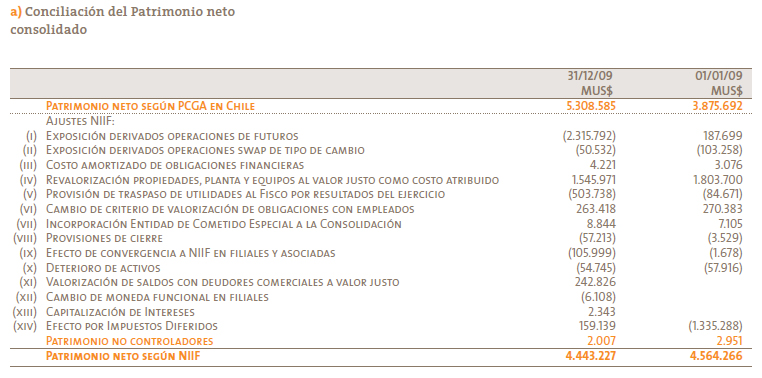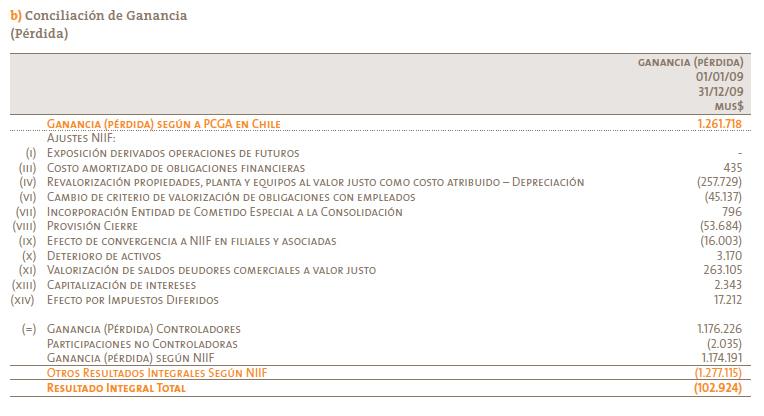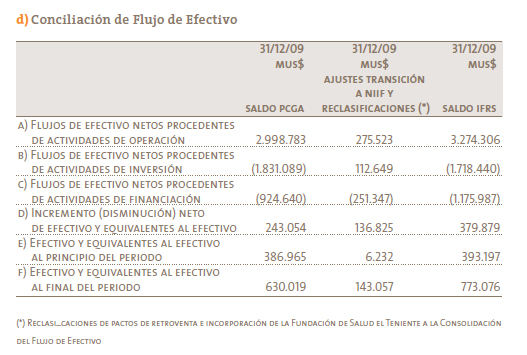Transition to International Financial reporting standards
First time adoption of IFRS
a) Basis of Transition to IFRS – Until December 31, 2009, Codelco Chile and subsidiaries prepared their financial statements in conformity with accounting principles generally accepted in Chile and standards and instructions issued by the Superintendency of Securities and Insurance.
As per the above stated, the Corporation established January 1, 2009 as its IFRS transition date, defining it as the period for the measurement of the effects of the first application.
Application of IFRS 1
The consolidated financial statements of the Corporation for the period ended December 31, 2009 are the first consolidated financial statements prepared in conformity with International Financial Reporting Standards (IFRS). The Corporation has applied IFRS 1 when preparing its consolidated financial statements.
In general, IFRS 1 requires the complete retrospective application of the standards and interpretations effective at the date of the first application. However, such standard allows certain exemptions to the retrospective application, in order to assist the companies with their transition process.
b) The Corporation has analyzed these exemptions and has applied the following:
- Business Combinations – The Corporation decided not to apply retrospectively IFRS 3, Business Combinations, maintaining the previous carrying amounts of the previous combinations.
- Fair Value as Deemed Cost – The Corporation measured certain items of property, plant and equipment existing at the transition date of IFRS at fair value and used that fair value as its deemed cost.
- Exchange Rate Differences on Translation – The Corporation considered that the cumulative translation differences will be deemed to be zero at the transition date. Hereby, all profit or loss from subsequent disposals due to these operations will exclude translation differences originated before the transition date.
- Assets and Liabilities of Subsidiaries, Associates and Joint Ventures – The subsidiaries, associates and joint ventures have adopted IFRS on the same date as the Corporation.
- Changes in Existing Liabilities for Decommissioning and Restoration – The Corporation has measured the decommissioning obligation – at the transition date – through the calculation of the net present value of the liability, using a discount interest rate that is representative of its indebtedness, correcting the accumulated depreciation.
In relation to the restoration provision, this has been determined at the net present value of the liability at the transition date. - Leases – The Corporation adopted the transitional provisions of IFRIC 4, Determining whether an arrangement contains a lease to determine whether the existing agreements and contracts at the transition date to IFRS, qualify as a lease based on the facts and circumstances at the transition date.
- Borrowing Costs – The Corporation adopted the criterion of capitalizing borrowing costs for work in progress, only for those works with a commencement date on or after January 1, 2009.
- Financial Instruments – The Corporation applies hedge accounting for its derivative instruments.
Reconciliations between Generally Accepted Accounting Principles in Chile (“Chilean GAAPâ€) and International Financial Reporting Standards (“IFRSâ€)


c) Explanations of the Main Differences
(i) Exposure of Derivatives on Futures Operations
Under Chilean GAAP, these futures contracts were designated as hedging instruments in a cash flow hedge. Codelco recorded the exposure to the derivatives in control accounts, and the change in the fair value of these operations was disclosed in the explanatory notes to the financial statements. Under IFRS, in a cash flow hedge the portion of the profit or loss on theonsedging instrument that is determined to be an effective hedge is recognized in equity.
The IFRS adjustment in profit or loss corresponds to the portion of the change in the time value of the option contracts that was designated as a hedging instrument.
(ii) Exposure of Derivatives on Exchange Rate Swaps
The adjustment in net equity corresponds to the same GAAP difference as for the exposure of derivatives on futures operations.
(iii) Financial Obligations at Amortized Cost
Under Chilean GAAP, Codelco recognized in profit or loss the expenses for bank loans and recognized in assets or liabilities the premiums, discounts and costs of transactions related to the issuance of bonds and whose effect in profit or loss was recognized amortizing these according to the straight-line method over the period of the respective obligations. Under IFRS, this methodology is modified amortizing the expenses under the amortized cost method, based on the effective rate of the obligation.
(iv) Fair Value of Property, Plant and Equipment as Deemed Cost
Codelco, making use of the exemption of IFRS 1, has restated certain items of property, plant and equipment based on a methodology of determining the fair value applied by independent advisors. Useful lives associated to certain assets, based on technical and economic criteria were also redefined from such study.
The effect in net equity arises from the increase in the value of the asset, net of deferred taxes, while the effect in profit (loss) is generated by a higher depreciation associated to the amount added to the asset.
(v) Provision for the Transfer of net income for the public treasury
According to Article 6 of D.L. 1,350, the revenues generated by the Corporation belong to the State and, prior to discounting the authorized amounts – through the procedure indicated in such article – for the capitalization and reserve funds, they shall be incorporated to the general revenues of the State. Only at this point, as per Chilean GAAP, the corresponding amount was included in the financial statements.
The application of IFRS determines the need to accrue a provision for the amounts transferred to the State, in the financial statements corresponding to the year in which the revenues to be transferred were generated.
(vi) Criteria Changes Defined Benefits Obligations with Employees
The obligations of the Corporation with its employees for the concept of severance payments were recorded, under Chilean GAAP, at their current value, that is, based on the final remuneration of the employee, multiplied by his service years.
According to IFRS, these provisions are calculated at net present value discounted at a discount rate based on a representative indebtedness rate, adding the use of certain actuarial assumptions, such as the retirement rates, mortality, turnover, etc.
Its equity effects are derived from a decrease in the provision associated with these obligations, generated by the application of the financial discount, while the effect on profit or loss is caused by the impact on costs of sales, financial expenses and exchange rate differences.
(vii) Special Purpose Entity Incorporated on Consolidation
According to the evaluation performed by the Corporation from the point of view of the application of SIC 12, Fundación de Salud El Teniente (FUSAT) meets the conditions to qualify as a Special Purpose Entity.
The consolidation of this entity implies that its net equity has to be added to the net equity of the Corporation. The effect on profit or loss is given by the consolidation of its profit (loss) in the results of Codelco.
(viii) Closure provision
The dismantling costs of assets, that are part of the provision made by Codelco according to Chilean GAAP for the concepts of closing mining sites, dams and other closure expenses, were charged directly in profit or loss for the year in which such a provision was generated. Due to the application of IFRS, some of these costs have to be charged to the value of the assets over which such disbursements were applied.
The impact on equity arises from the correction of the effect recorded in profit or loss of prior years, in which the total cost was charged under Chilean GAAP and which according to IFRS is deferred according to the depreciation of the assets to be dismantled, net of other effects associated with the calculation of this provision in accordance with IAS 37.
(ix) Effect of Convergence to IFRS of Subsidiaries and Associates
Each subsidiary and associate performed its convergence process to IFRS, in which impacts of different nature were generated. The effects of these impacts were transferred both to the consolidated net equity, as well as to the profit (loss) of Codelco.
(x) Impairment of Assets
At the date of transition to IFRS, the Corporation performed an asset impairment tests in accordance with IAS 36. Such tests concluded that the recoverable amounts of the assets for the Cash Generating Unit “División Ventanas†were lower than the carrying amounts of the assets of such unit. Consequently, the adjustments recorded as a result of were mainly the total write-off of the goodwill recognized in the Corporation’s assets, which were previous the transition to IFRS and generated by the acquisition of Fundición Las Ventanas in 2005, in addition to the partial decrease in items of Property, Plant and Equipment of the aforementioned CGU, and the related negative effect on equity. At the Statement of Income by Function level, the effect of this adjustment was reversing the depreciation charges of the impaired assets in their corresponding proportion.
(xi) Valuation of Trade Receivables at Fair Value through Profit or Loss
When applying Chilean GAAP, the estimations of lower sales revenues, in open operations at year-end, were accrued with direct effect on profit or loss, according to the available information at the preparation date of the financial statements and are presented deducting the balance of the trade debtors. As per IFRS, both the estimations of lower and higher revenues are recognized directly in profit or loss.
(xii) Change of Functional Currency in the Subsidiaries
Some subsidiaries have changed their functional currency according to IAS 21, adopting the functional currency of Codelco (US dollar). Because under Chilean GAAP these companies continued to be valued in Chilean pesos, the effects of the adjustments to the change that were recorded in equity during year-end 2009, have to be reversed for the purposes of the application of IFRS.
(xiii) Capitalization of Interest
According to IFRS, there are financial costs that are directly related to the acquisition, construction or production of qualifying assets and, therefore, they need to be capitalized as a cost of such assets. According to this treatment, the Corporation has identified those qualifying assets and the directly related financing costs that must be capitalized.
In this context, the effect on equity is caused by a lower expense recognized in profit or loss for the capitalization of interest, treatment that was optional under Chilean GAAP.
(xiv) Effect of Deferred Taxes
The net deferred taxes generated by the IFRS adjustments subject to the tax rates are included. d) Reconciliation of Cash Flows





